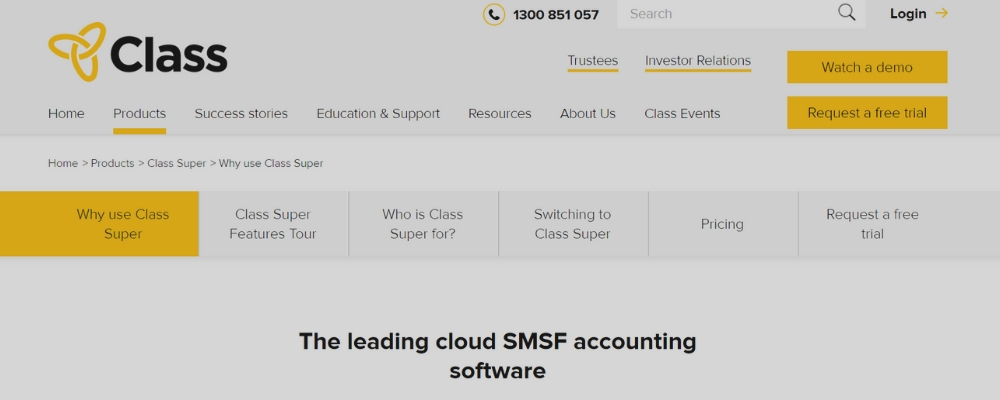Your Statement of Position might show up to five tax positions in Class. Here is a short overview of what is what.
Tax Positions in Class
In Class your Statement of Financial Position can show four different tax positions for income tax and two for GST. For income tax you might see:
Income Tax Payable
Provision for Income Tax
Deferred Tax Liablity
Income Tax Instalments Paid
And if your SMSF is registered for GST, for example because you hold commercial properties in your fund, then you also might have these tax positions – if your SMSF is not registered, then you won’t see these.
Activity Statement Payable/Refundable
GST Payable / Refundable
Let’s run through these one by one. Let’s assume you are working on the accounts for 30 June 2019. So the previous year is 30 June 2018.
Income Tax Payable
This position can be a liability as well as an asset. But ideally it should be nil and not even appear in your statement of financial position. If all is well and the SMSF paid all its tax liabilities and got all its tax refunds it is liable and entitled to for 2018 within the 2019 financial year, this position doesn’t show at all. So if it does show, it is worth asking why. There are various possible reasons.
Maybe the SMSF lodged late and so the ATO didn’t have time to pay the refund for 2018 by 30 June 2019. Or the SMSF didn’t have time or cash to pay its tax liabilities for 2018 by 30 June 2019. Or there is a mistake in the opening balance or a mistake along the line. Whatever it is, it is worth asking the question and checking whether there really still is an outstanding tax liability or asset and why.
Provision for Income Tax
This is the anticipated tax payable for 2019 before taking any income tax instalments into account. The anticipated liability only becomes an actual liability upon assessment. Only with an assessment the ATO receives an enforceable right for collection. And that happens after 30 June. So as of 30 June the SMSF only recognises a provision, not a liability.
What actually shows as a Provision for Income Tax will be different from the tax payable or refund listed under Section D of the annual return. And the reason is that the net payable or refundable on the tax return includes PAYG instalments as well as supervisory levy, but the Provision for Income Tax doesn’t. If this confuses, run the Statement of Taxable Income in Class and go to the reconciliation at the every end of the report. I think this might make it clear.
The Provision for Income Tax might actually be an asset, especially when the fund is fully in retirement phase and entitled to a franking credit refund.
Deferred Tax Liability
This would only show if you do tax-effective accounting. This is not usually done for a super fund for various reasons, the main one that you have varying tax rates within the fund over time. So just turn off tax- effective accoutning in the fund settings in Class.
Income Tax Instalments Paid
This one is easy. It is the total amount of BAS payments for PAYG I the fund made. The amount shown here should agree with the amount shown in the Tax Agent Portal when you go to > Client Accounts > Integrated Client Account > More Display Options > By income tax year: Tax type summary.
And so the balance of these three positions is the actual amount the SMSF will have to pay to settle its tax debt for the 2019 tax year. This balance does not include the SMSF levy. The levy is recognised as an expense when the SMSF pays its tax debt.
The next two positions your statement of financial position will only show if your SMSF is registered for GST.
Activity Statement Payable / Refundable
This is the balance of all BAS statements you have lodged but that remain unpaid – GST as well as PAYG instalments. Usually this line shows your BAS statement for the June quarter.
It is easy to forget the BAS statement for the June quarter. So if this line is zero, check that you have entered the BAS for June 2019 into Class. You match the BAS statement as of 30 June 2019 with the later payment. And show the June BAS amount as a payable or refundable in your SMSF’s statement of financial position.
GST Payable / Refundable
If the GST position in your lodged BAS statements doesn’t agree with your actual GST position in Class, then this line will tell you. So ideally this line should be zero. If it isn’t, you probably need to amend the BAS statements you lodged.
MORE
Disclaimer: Tax Talks does not provide financial or tax advice. All information on Tax Talks is of a general nature only and might no longer be up to date or correct. You should seek professional accredited tax and financial advice when considering whether the information is suitable to your or your client’s circumstances.
